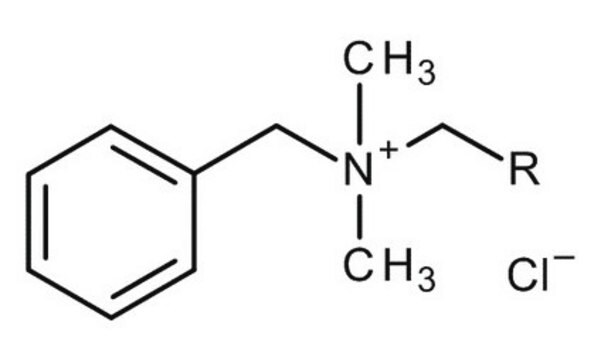B6295
Benzalkonium chloride
BioXtra
Synonym(s):
Alkylbenzyldimethylammonium chloride, Alkyldimethylbenzylammonium chloride
About This Item
Recommended Products
description
cationic
Quality Level
product line
BioXtra
Assay
95.0-105.0% (calculated on dry substance)
form
(Solid or Semi-Solid or Viscous Liquid)
impurities
≤0.001% Phosphate
≤0.1% Insoluble matter
≤10% water
ign. residue
≤2%
anion traces
sulfate (SO42-): ≤0.05%
cation traces
Al: ≤0.0005%
Ca: ≤0.0005%
Cu: ≤0.0005%
Fe: ≤0.0005%
K: ≤0.005%
Mg: ≤0.0005%
Na: ≤0.02%
Pb: ≤0.001%
Zn: ≤0.0005%
SMILES string
[Cl-].CCCCCCCCCCCCCC[N+](C)(C)Cc1ccccc1
InChI
1S/C19H34N.ClH/c1-4-5-6-7-8-9-10-14-17-20(2,3)18-19-15-12-11-13-16-19;/h11-13,15-16H,4-10,14,17-18H2,1-3H3;1H/q+1;/p-1
InChI key
TTZLKXKJIMOHHG-UHFFFAOYSA-M
Looking for similar products? Visit Product Comparison Guide
General description
Application
Disclaimer
Signal Word
Danger
Hazard Statements
Precautionary Statements
Hazard Classifications
Acute Tox. 4 Dermal - Acute Tox. 4 Oral - Aquatic Acute 1 - Aquatic Chronic 1 - Eye Dam. 1 - Skin Corr. 1B
Storage Class Code
8B - Non-combustible corrosive hazardous materials
WGK
WGK 2
Flash Point(F)
Not applicable
Flash Point(C)
Not applicable
Personal Protective Equipment
Choose from one of the most recent versions:
Already Own This Product?
Find documentation for the products that you have recently purchased in the Document Library.
Customers Also Viewed
Our team of scientists has experience in all areas of research including Life Science, Material Science, Chemical Synthesis, Chromatography, Analytical and many others.
Contact Technical Service








